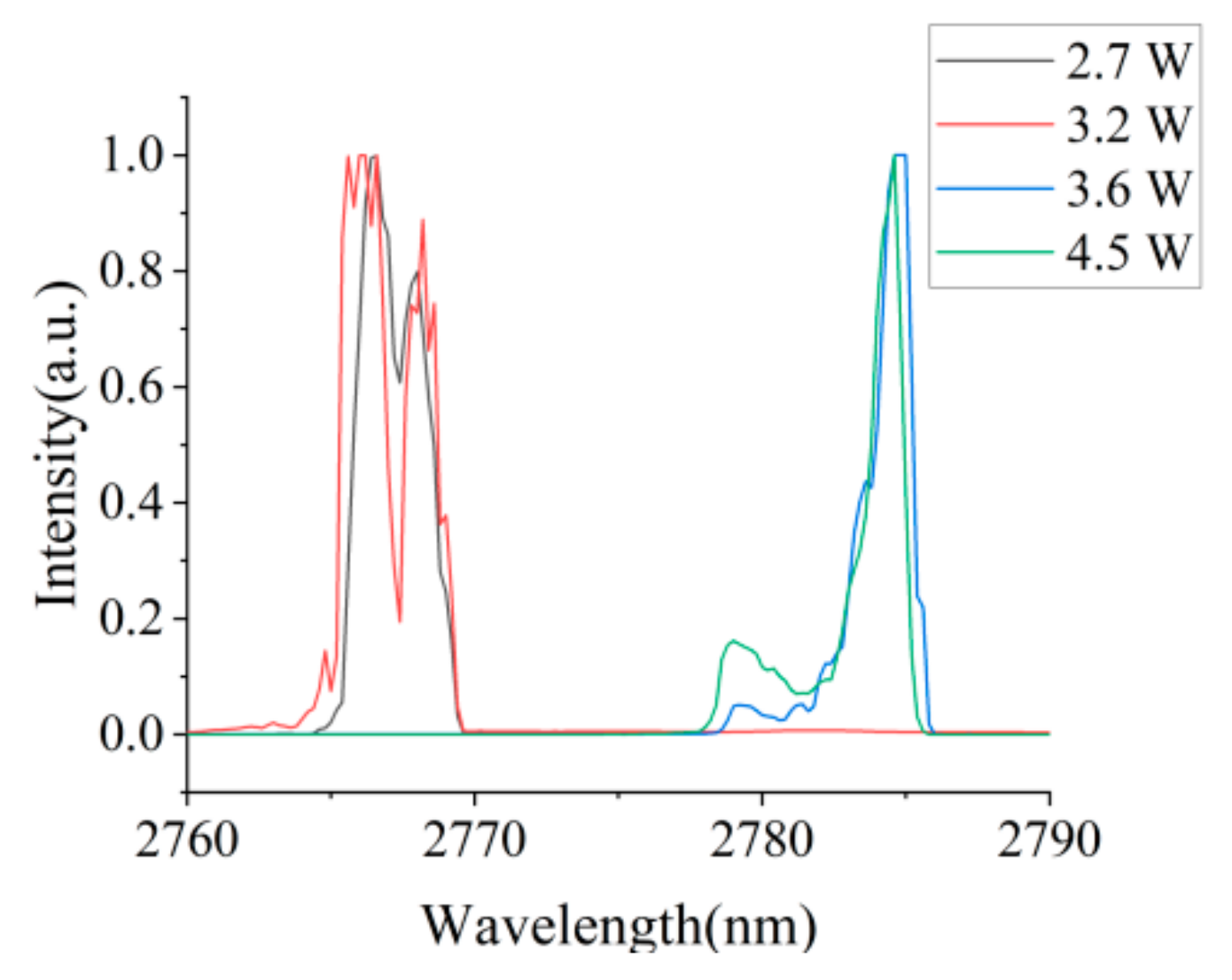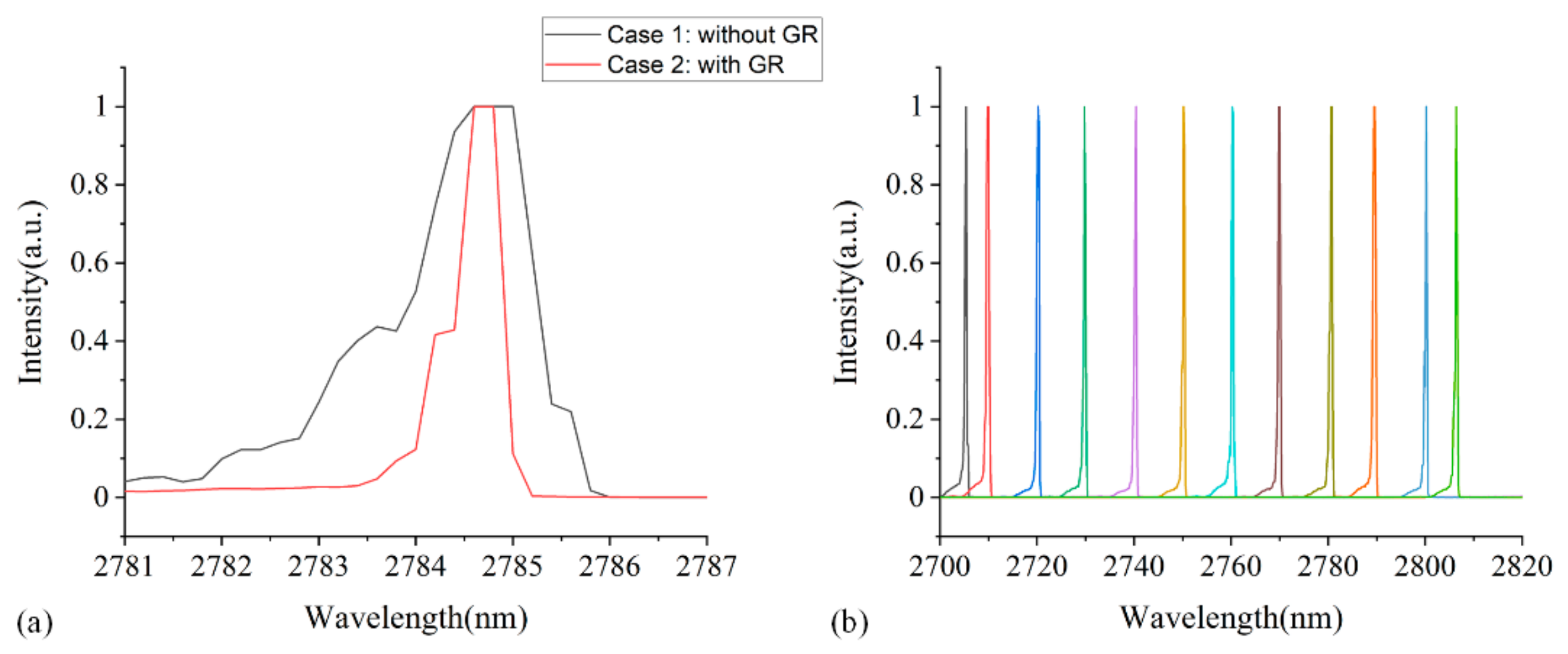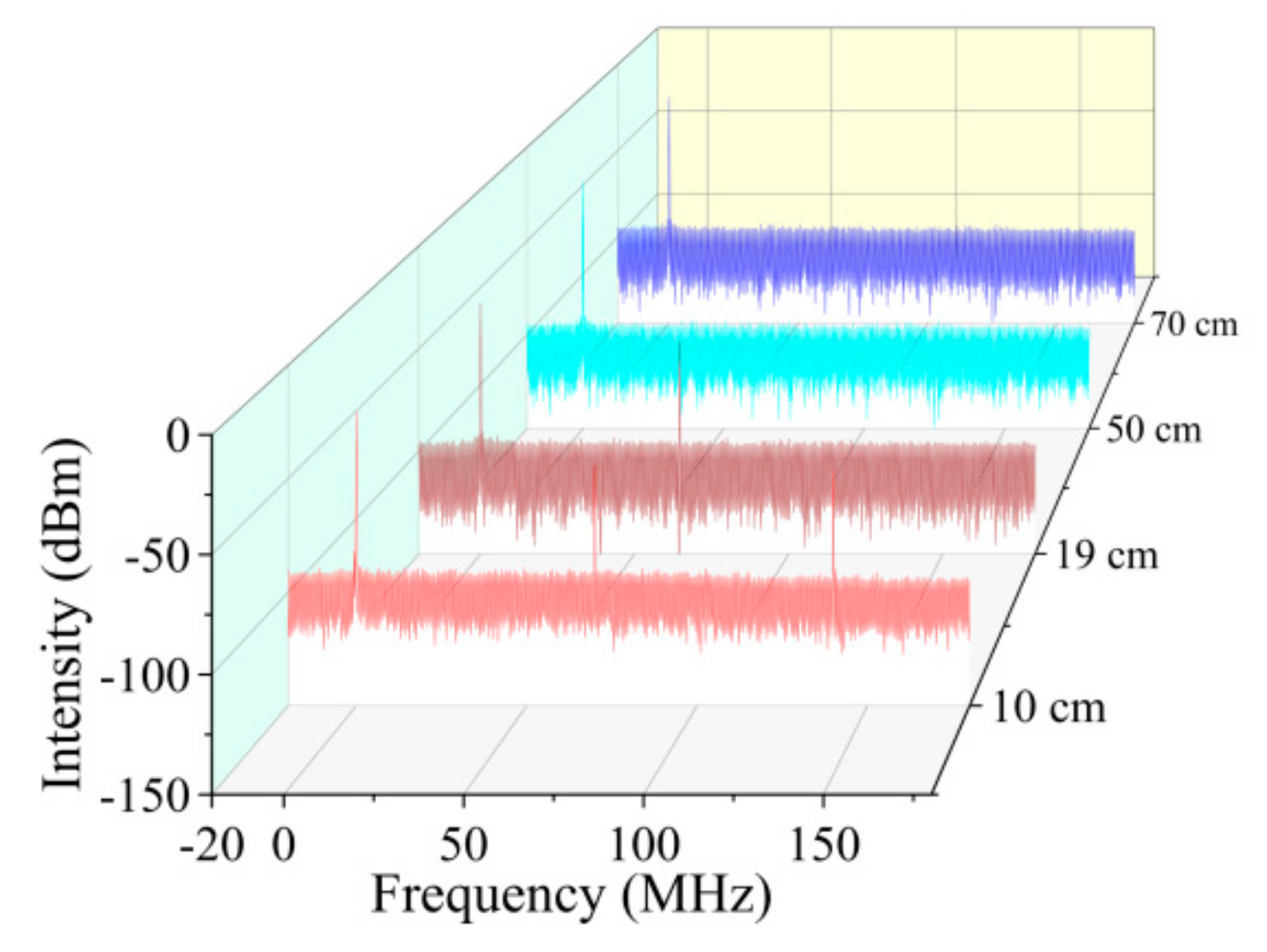Widely Wavelength-Tunable High Power Single-Longitudinal-Mode Fiber Laser in Mid-Infrared Waveband
Abstract
:1. Introduction
2. Materials and Methods
3. Results
4. Discussion
5. Conclusions
Author Contributions
Funding
Institutional Review Board Statement
Informed Consent Statement
Data Availability Statement
Conflicts of Interest
References
- Geng, J.; Jiang, S. Fiber lasers: The 2 μm market heats up. Opt. Photon. News 2014, 25, 34–41. [Google Scholar] [CrossRef]
- Boulnois, J.L. Photophysical processes in recent medical laser developments: A review. Lasers Med. Sci. 1986, 1, 47–66. [Google Scholar] [CrossRef]
- Masters, B.R. Three-dimensional microscopic tomographic imaging of the cataract in a human lens in vivo. Opt. Express 1998, 3, 332–338. [Google Scholar] [CrossRef] [PubMed]
- Yelin, D.; Oron, D.; Thiberge, S.; Moses, E.; Silberberg, Y. Multiphoton plasmon-resonance microscopy. Opt. Express 2003, 11, 1385–1391. [Google Scholar] [CrossRef] [PubMed]
- Tittel, F.K.; Richter, D.; Fried, A. Mid-infrared laser applications in spectroscopy. In Solid-State Mid-Infrared Laser Sources; Sorokina, I.T., Vodopyanov, K.L., Eds.; Springer: Heidelberg/Berlin, Germany, 2003; pp. 458–529. [Google Scholar]
- Hodgkinson, J.; Tatam, R.P. Optical gas sensing: A review. Meas. Sci. Technol. 2012, 24, 012004. [Google Scholar] [CrossRef] [Green Version]
- Kühnemann, F.; Schneider, K.; Hecker, A.; Martis, A.; Urban, W.; Schiller, S.; Mlynek, J. Photoacoustic trace-gas detection using a cw single-frequency parametric oscillator. Appl. Phys. B 1998, 66, 741–745. [Google Scholar] [CrossRef]
- Li, J.; Parchatka, U.; Fischer, H.A. Formaldehyde trace gas sensor based on a thermoelectrically cooled CW-DFB quantum cascade laser. Anal. Methods 2014, 6, 5483–5488. [Google Scholar] [CrossRef] [Green Version]
- Kang, Z.; Mei, C.; Zhang, L.Q.; Evans, J.; He, S. Advanced Progress on χ(3) Nonlinearity in Chip-Scale Photonic Platforms. Prog. Electromagn. Res. 2021, 170, 17–62. [Google Scholar] [CrossRef]
- Petersen, C.R.; Møller, U.; Kubat, I.; Zhou, B.; Dupont, S.; Ramsay, J.; Benson, T.; Sujecki, S.; Abdel-Moneim, N.; Tang, Z. Mid-infrared supercontinuum covering the 1.4–13.3 μm molecular fingerprint region using ultra-high NA chalcogenide step-index fibre. Nat. Photonics 2014, 8, 830–834. [Google Scholar] [CrossRef]
- Lai, J.Y.; Guo, H.T.; Chen, Y.C.; Hsu, C.W.; Wu, D.Y.; Chou, M.H.; Yang, S.D. Single-frequency Mod-hop Free Tunable 3 μm Laser Pumped by a 2W Diode for Isotopic Gas Sensing. In Proceedings of the Conference on Lasers and Electro-Optics, San Jose, CA, USA, 13–18 May 2018. [Google Scholar]
- Shukla, M.K.; Das, R. High-power single-frequency source in the mid-infrared using a singly resonant optical parametric oscillator pumped by Yb-fiber laser. IEEE J. Sel. Top. Quantum Electron. 2017, 24, 1–6. [Google Scholar] [CrossRef]
- Wang, Q.; Wang, X.; Li, Z. Stable and tunable single frequency mid-infrared optical parametric oscillator on High Power Lasers. In Proceedings of the SPIE on High Energy Lasers, and Silicon-Based Photonic Integration, Beijing, China, 19 October 2016; p. 1015209. [Google Scholar]
- Zhao, J.; Cheng, P.; Xu, F.; Zhou, X.; Tang, J.; Liu, Y.; Wang, G. Watt-level continuous-wave single-frequency mid-infrared optical parametric oscillator based on mgo: Ppln at 3.68 µm. Appl. Sci. 2018, 8, 1345. [Google Scholar] [CrossRef] [Green Version]
- Jiang, X.; Chen, F.; Lu, Y.; Yin, T.; He, S. Generating Picosecond Pulses with the Largest Number of Lasing Wavelengths by an All-Fiber Optical Parametric Oscillator. Prog. Electromagn. Res. 2020, 167, 11–17. [Google Scholar] [CrossRef]
- Wang, M.; Hosoda, T.; Shterengas, L.; Kipshidze, G.; Lu, M.; Stein, A.; Belenky, G. External cavity cascade diode lasers tunable from 3.05 to 3.25 μm. Opt. Eng. 2017, 57, 011012. [Google Scholar] [CrossRef]
- Totschnig, G.; Winter, F.; Pustogov, V.; Faist, J.; Müller, A. Mid-infrared external-cavity quantum-cascade laser. Opt. Lett. 2002, 27, 1788–1790. [Google Scholar] [CrossRef] [PubMed]
- Bernier, M.; Michaud-Belleau, V.; Levasseur, S.; Fortin, V.; Genest, J.; Vallée, R. All-fiber DFB laser operating at 2.8 μm. Opt. Lett. 2015, 40, 81–84. [Google Scholar] [CrossRef] [PubMed]
- Hudson, D.D.; Williams, R.J.; Withford, M.J.; Jackson, S.D. Single-frequency fiber laser operating at 2.9 μm. Opt. Lett. 2013, 38, 2388–2390. [Google Scholar] [CrossRef] [PubMed]
- Wysocki, G.; Curl, R.F.; Tittel, F.K.; Maulini, R.; Bulliard, J.M.; Faist, J. Widely tunable mode-hop free external cavity quantum cascade laser for high resolution spectroscopic applications. Appl. Phys. B 2005, 81, 769–777. [Google Scholar] [CrossRef]
- Seger, K.; Meiser, N.; Canalias, C.; Pasiskevicius, V.; Laurell, F. Tunable, passively Q-switched single-longitudinal-mode Nd:YVO4 laser using a chirped volume Bragg grating. Appl. Phys. B 2012, 109, 99–103. [Google Scholar] [CrossRef]








Publisher’s Note: MDPI stays neutral with regard to jurisdictional claims in published maps and institutional affiliations. |
© 2021 by the authors. Licensee MDPI, Basel, Switzerland. This article is an open access article distributed under the terms and conditions of the Creative Commons Attribution (CC BY) license (http://creativecommons.org/licenses/by/4.0/).
Share and Cite
Lu, Y.; Jiang, X.; Chen, F.; Lu, C.; He, S. Widely Wavelength-Tunable High Power Single-Longitudinal-Mode Fiber Laser in Mid-Infrared Waveband. Appl. Sci. 2021, 11, 2073. https://doi.org/10.3390/app11052073
Lu Y, Jiang X, Chen F, Lu C, He S. Widely Wavelength-Tunable High Power Single-Longitudinal-Mode Fiber Laser in Mid-Infrared Waveband. Applied Sciences. 2021; 11(5):2073. https://doi.org/10.3390/app11052073
Chicago/Turabian StyleLu, Yi, Xiaogang Jiang, Feihong Chen, Chenlong Lu, and Sailing He. 2021. "Widely Wavelength-Tunable High Power Single-Longitudinal-Mode Fiber Laser in Mid-Infrared Waveband" Applied Sciences 11, no. 5: 2073. https://doi.org/10.3390/app11052073
APA StyleLu, Y., Jiang, X., Chen, F., Lu, C., & He, S. (2021). Widely Wavelength-Tunable High Power Single-Longitudinal-Mode Fiber Laser in Mid-Infrared Waveband. Applied Sciences, 11(5), 2073. https://doi.org/10.3390/app11052073





